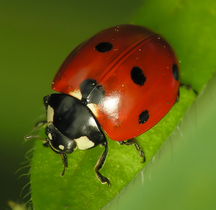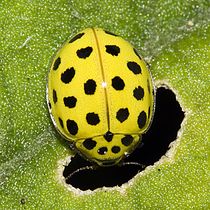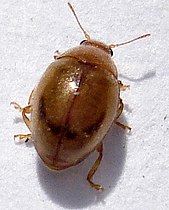
A | B | C | D | E | F | G | H | CH | I | J | K | L | M | N | O | P | Q | R | S | T | U | V | W | X | Y | Z | 0 | 1 | 2 | 3 | 4 | 5 | 6 | 7 | 8 | 9
| Ladybird, ladybug, lady beetle Temporal range:
| |
|---|---|

| |
| Coccinella septempunctata | |
| Scientific classification | |
| Domain: | Eukaryota |
| Kingdom: | Animalia |
| Phylum: | Arthropoda |
| Class: | Insecta |
| Order: | Coleoptera |
| Suborder: | Polyphaga |
| Infraorder: | Cucujiformia |
| Superfamily: | Coccinelloidea |
| Family: | Coccinellidae Latreille, 1807[1] |
| Subfamilies[1] | |
|
(traditional, but see below):
| |
| Synonyms | |
| |
Coccinellidae (/ˌkɒksɪˈnɛlɪdiː/)[3] is a widespread family of small beetles. They are commonly known as ladybugs in North America and ladybirds in the United Kingdom; "lady" refers to mother Mary. Entomologists use the names ladybird beetles or lady beetles to avoid confusion with true bugs. The more than 6,000 described species have a global distribution and are found in a variety of habitats. They are oval beetles with a domed back and flat underside. Many of the species have conspicuous aposematic (warning) colours and patterns, such as red with black spots, that warn potential predators that they taste bad.
Most coccinellid species are carnivorous predators, preying on insects such as aphids and scale insects. Other species are known to consume non-animal matter, including plants and fungi. They are promiscuous breeders, reproducing in spring and summer in temperate regions and during the wet season in tropical regions. Many predatory species lay their eggs near colonies of prey, providing their larvae with a food source. Like most insects, they develop from larva to pupa to adult. Temperate species hibernate and diapause during the winter; tropical species are dormant during the dry season. Coccinellids migrate between dormancy and breeding sites.
Species that prey on agricultural pests are considered beneficial insects. Several species have been introduced outside their range as biological control agents, with varying degrees of success. Some species are pests themselves and attack agricultural crops, or can infest people's homes, particularly in winter. Invasive species like Harmonia axyridis can pose an ecological threat to native coccinellid species. Other threats to coccinellids include climate change and habitat destruction. These insects have played roles in folklore, religion and poetry, and are particularly popular in nursery rhymes.
Etymology
The name Coccinellidae, created by Pierre André Latreille in 1807,[4] is derived from the Latin word coccineus meaning 'scarlet'.[5] The common English name ladybird originated in Britain where the insects became known as "Our Lady's birds".[6][7] Mary ("Our Lady") was often depicted wearing a red cloak in early art, and the seven spots of the species Coccinella septempunctata (the most common in Europe) were said to represent her seven joys and seven sorrows.[8] In the United States, the name was popularly adapted to ladybug.[9] Entomologists prefer the names ladybird beetles or lady beetles to avoid confusion with true bugs.[9][10][11][12] Names in some other countries may be similar; for example, in Germany they are known as Marienkäfer meaning 'Marybeetle' or 'ladybeetle'.[9]
Description
Coccinellids range in size from 0.8 to 18 mm (0.03–0.7 in).[13] They are sexually dimorphic; adult females tend to be slightly larger than males.[14] They are generally oval with domed backs and flattened undersides.[7] They have large compound eyes and clubbed antennae with seven to eleven segments. The powerful mandibles (equivalent to jaws) typically have pairs of "teeth" which face each other.[15] The coccinellid prothorax (front of thorax) is broad and convex, and can cover the back of the head.[16][17] Being beetles, they have hardened, non-overlapping forewings, known as elytra, which cover up the more fragile hindwings when the insects are not in flight. Their legs are relatively short,[16] with a tarsal formula of 4-4-4 or 3-3-3.[18] The tarsus (end of leg) has two claws at the tip.[16]
As adults, these beetles differ from their closest relatives with the following morphological characteristics:[18]
- Five pairs of spiracles (holes) on the abdomen
- A tentorium (internal supports inside the head) with separated branches at the front and no bridge
- No line dividing the frons and clypeus (frontoclypeal suture)
- Maxillary palps with non-needle-shaped tips,
- Divided galea and lacinia (lobes at the end of the mouthparts)
- Smaller molar (flattened) area of the mandible
- Coxal cavities (holes where the leg articulates with the thorax) that open from the back in the front of the thorax and from the front in the middle of the thorax
- Epimeron (corner plates) on the metathorax with parallel edges
- Lines on the second abdominal sternum
- Tube-shaped, siphon-like genitalia in the male
Coccinellids are often distinctively coloured and patterned. The elytron may be light with dark spots or dark with light spots. Light areas are typically yellow, red, orange or brown, and the spots vary in size and shape and numbers. Some species have striped or checkered patterns. The pigment carotene creates the lighter colours, and melanins create darker colours. Other parts of the body also vary in colouration.[7][19] These colour patterns typically serve as warning colouration, but some can act as camouflage, attract mates or even regulate heat.[7][20] Several individual species may display polymorphism and even change colour between seasons.[7]
Coccinellid larvae are elongated with square heads.[21] They are covered in hairs or setae, the abdominal segments, in particular, each having six divided into pairs, and one to three segmented antennae.[18][7] Their colouration varies from grey, blue-grey, grey-brown or brown and spotted with white, yellow, red or orange. They tend to brighten as they get closer to adulthood.[22]
- Appearance of different species
-
Coccinella septempunctata, black spots on red
-
Psyllobora vigintiduopunctata, black spots on yellow
-
Vibidia duodecimguttata, whitish spots on brown
-
Brumoides suturalis, longitudinally striped
-
Rhyzobius chrysomeloides, brown, unspotted
Evolution
Fossil history
Over 6,000 living species of Coccinellidae have been described.[13] They are sparsely preserved in the fossil record.[23] Although molecular clock estimates have placed their origin in the Cretaceous, the oldest fossils of the group are known from the Oise amber of France, dating to the Early Eocene (Ypresian) around 53 million years ago, which belong to the extant genera Rhyzobius and Nephus.[24] The greatest number of fossils comes from the younger Eocene Baltic amber, including members of the extant genera Serangium[25] and Rhyzobius as well as extinct genera belonging to the tribes Microweiseini (Baltosidis)[26] and Sticholotidini (Electrolotis).[23]
Phylogeny
The Coccinellidae are within the superfamily Coccinelloidea, which in turn is part of the infraorder Cucujiformia, a group containing most of the plant-eating beetles. The ladybirds form the majority of the species in the Coccinelloidea; many of the rest are fungus-feeding beetles or scavengers.[27]
| Cucujiformia |
| |||||||||||||||||||||||||||||||||||||||||||||
Coccinellidae have historically been divided into up seven subfamilies (Chilocorinae, Coccidulinae, Coccinellinae, Epilachninae, Microweiseinae, Scymninae and Sticholotidinae) and 35 tribes based on morphology. However, genetics studies have called into question the monophyly (single ancestry) of most of these subfamilies. The monophyly of Coccinellinae has the most support.[28][29]
A 2021 genetic study sampling many species, identified three subfamilies, Microweiseinae (with three tribes), Coccinellinae (26 tribes) and a newly identified group, the Monocoryninae (one tribe). All three subfamilies were strongly supported, but the study noted that although the tribes are mostly monophyletic, their relationships are only weakly supported. The study suggests that the crown group appeared some 143 Mya in the Early Cretaceous, and that the group diversified rapidly during the Late Cretaceous, perhaps because the growth in diversity of angiosperm plants then encouraged the radiation of insects of the clade Sternorrhyncha such as aphids, on which ladybirds could feed.[30]





